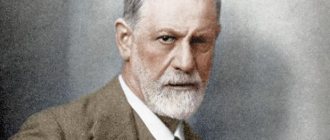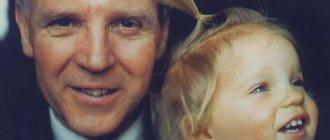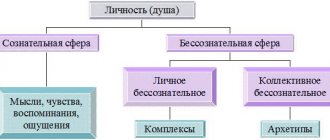General characteristics of personality theories
Currently, there is no generally accepted opinion about what approach personologists should take to the study of personality to explain the main aspects of human behavior. In fact, at this stage of development of personology, various alternative theories coexist, describing the personality as an integrated whole and at the same time explaining the differences between people. Therefore, first of all, let us dwell on what this or that theory is and what methods it uses to study and understand man. A theory is a system of interrelated ideas, constructs and principles that aims to explain certain observations of reality. A theory is always speculative in its essence and therefore, strictly speaking, cannot be “right” or “wrong.” However, a theory is generally accepted in the scientific world as valid and trustworthy to the extent that the results of observations of a phenomenon (usually based on data obtained in specific experiments) are consistent with the explanation of the same phenomenon implied by the theory itself. If human behavior were completely understandable from the point of view of ordinary common sense, there would be no need to create theories of personality. Personality theories are carefully calibrated conclusions or hypotheses about what people are like, how they behave, and why they act the way they do.
Theories have two main functions: they explain and predict behavior. Personality theory is explanatory in the sense that it presents behavior as organized in a certain way that makes it understandable. In other words, a theory provides a semantic framework or schema that allows us to simplify and interpret everything we know about the relevant class of events. The explanatory function of a theory becomes especially important when we are dealing with a huge number of facts and observations related to behavior. A good theory of personality provides a meaningful context within which it becomes possible to consistently describe and interpret human behavior.
A theory must not only explain past and present events, but also predict future ones. It should provide a basis for predicting outcomes and events that have not yet occurred. This goal clearly implies that theoretical concepts should not only be open to testing, but that they may or may not be confirmed. A good theory of personality directly stimulates psychological research. Conversely, the scientific value of untestable theories (that is, those that cannot be used to make predictions for further research) cannot be determined. Theories must have an exploratory impulse if they are to contribute to our understanding of human nature in all its uniquely individual manifestations.
Personality theories serve different functions in psychology. They enable us to explain what people are like (identify relatively constant personality characteristics and the way they interact), understand how these characteristics develop over time, and why people behave in certain ways. Theories also allow us to predict the emergence of new relationships that have not been studied before. From the perspective of the predictive function, theories outline directions in which planned research can lead to new discoveries in many hitherto unexplored areas. However, it is extremely important that all theories of human behavior are created by people themselves. Personologists are the same people and, just like others, have different views on human nature. For example, some theorists are convinced that the roots of human actions are deep in unconscious motives, the true nature of the latter is not realized by the individual, and the sources of motivation are buried in the distant past. Others believe that people are largely aware of their motives and that their behavior is primarily the result of current circumstances. Whatever the opinion of each particular theorist, it is quite clear that the basic assumptions about human nature held by personologists are different, and this is what makes their views so dissimilar. The theorist can realize and reveal the meaning of these provisions, or he may fail in this or simply generalize all his premises in such a way that it will be difficult to recognize exactly the initial provisions in them.
Bibliography
- Wittels F. “Freud (his personality, teaching and school).” Moscow, 1991: 345 p.
- James M.M. and D. Jongvard “Born to Win”. M., 1991.-274 P.
- Krysko V.G. Social Psychology. M., 2001.- 208 p.
- Nemov R.S. “Psychology” 2 vol. M., 1994.
- Z. Freud. Lectures on psychoanalysis. Lecture 31.p.334-349 6.
- Z. Freud, “Psychology of the Unconscious.” M., 1990. 215 pp.
- textbook on the history of psychology. In: Moscow State University. 1980. p. 184-188Z.
- Kjell L.D. Personality Theory 1997 pp. 106-153 S.
- Jung K.G. “Analytical psychology. Past and present". M., 1995, pp. 536 PAGE.
Psychodynamic direction in personality theory: Sigmund Freud.
According to Freud, the main driving factor in personality development are innate instincts, all the diversity of which is combined into two main groups: life instincts (Eros) and death instincts (Thanatos). Freud considered the most significant for the development of personality to be sexual instincts, the energy of which he called libido. Subsequently, Freud began to use the term “libido” to designate the energy of life instincts in general.
Freud identified three main personality structures: It (Id), I (Ego) and Superego (Superego). It represents the source of all the motivating energy that is necessary for human life activity. This energy is inherent in the sexual and aggressive drives that form an essential part of the id. The basic principle of the functioning of the id is the principle of pleasure. It seeks pleasure and avoids pain, strives for immediate and total release. The complete opposite of the Id is the Super-Ego, which represents the system of values, norms and rules of behavior accepted in society, as well as the ideals and punishments that a person expects if the rules are violated. The ego is the substructure of the personality responsible for making decisions. The ego, functioning in accordance with the reality principle, strives to satisfy the desires of the id, coordinating them with the requirements of the superego. The id, the ego and the superego are in constant struggle; strong conflicts between these structures can lead to mental and somatic illnesses.
Basic Concepts
Hyperthymic personality type - what is it in psychology
Personality is a social individual, a set of relationships, activities and behavior that characterizes a person.
Note! Personality theories in psychology are a set of hypotheses and definitions with the help of which the mechanisms of personal development are studied. Their main task is to explain human behavior, as well as learn to predetermine it.
Structural elements of personality theory in psychology
S. Freud is considered the author of the structural theory and structural principle of personality development. He conditionally divided the personality model into 3 components:
- Id (It). A congenital element that occurs when a child is born. At the same time, the baby strives to get something that will make him feel good here and now, no matter what. For example, loud crying until the need (to eat, to communicate) is met;
- Ego (I). Formed during the first 3 years of life. The child realizes that his behavior has a response. For example, before doing something forbidden, the Ego begins to remind you of possible negative consequences;
- Superego (Super Ego). It is in shape by the age of 5 years. This personal element is based on the principles and ideals received from parents and environment. It is considered equivalent to conscience due to the ability to evaluate “good” and “bad.”
Alfred Adler: individual theory of personality.
The idea that man is a single and self-consistent organism constitutes the main premise of Adlerian psychology. Adler gave his theory the name "individual psychology" because in Latin "individuum" means "indivisible" - that is, it means an entity that cannot be divided. Adler proceeded from the fact that not a single manifestation of life activity can be considered in isolation, but only in relation to the personality as a whole. The individual is an indivisible whole, both in relation to the relationship between the brain and the body and in relation to mental life.
Arguing that a person strives for perfection, Adler proceeded from the consideration that people do not push away from internal or external reasons, but rather pull forward - they are always in motion towards personally significant life goals.
Recognizing the importance of heredity and environment in the formation of personality, Adler insisted that the individual is more than just the product of these two influences (Adler, 1964). Namely, he believed that humans have a creative power that influences every facet of human experience: perception, memory, imagination, fantasy and dreams. It makes each person a self-determining individual, the architect of his own life.
Individual psychology views and studies the individual as embedded in society.
Carl Gustav Jung: analytical theory of personality.
Jung argued that personality consists of three separate but interacting structures: the ego, the personal unconscious, and the collective unconscious.
The ego is the center of the sphere of consciousness. It is a component of the psyche, which includes all those thoughts, feelings, memories and sensations through which we feel our integrity, constancy and perceive ourselves as people. The ego serves as the basis of our self-awareness, and thanks to it we are able to see the results of our ordinary conscious activities.
The personal unconscious contains conflicts and memories that were once conscious but are now repressed or forgotten. It also includes those sensory impressions that are not bright enough to be noted in consciousness. Jung notes that the personal unconscious contains complexes, or accumulations of emotionally charged thoughts, feelings and memories, brought by the individual from his past personal experience or from ancestral, hereditary experience. These complexes, arranged around the most common themes, can have a fairly strong influence on the behavior of an individual.
The collective unconscious is a repository of latent memory traces of humanity and even of our anthropoid ancestors. It reflects thoughts and feelings common to all human beings and resulting from our common emotional past. As Jung himself said, “the collective unconscious contains the entire spiritual heritage of human evolution, reborn in the structure of the brain of each individual.” Thus, the content of the collective unconscious is formed due to heredity and is the same for all humanity.
Jung hypothesized that the collective unconscious consists of powerful primary mental images called archetypes (literally, “primary patterns”) Archetypes are innate ideas or memories that predispose people to perceive, experience, and respond to events in a certain way. In reality, these are not memories or images as such, but rather predisposing factors under the influence of which people implement universal patterns of perception, thinking and action in their behavior in response to any object or event.
| Archetype | Definition | Symbols |
| Anima | The unconscious feminine side of a man's personality | Woman, Virgin Mary, Mona Lisa |
| Animus | The unconscious masculine side of a woman's personality | Man, Jesus Christ, Don Juan |
| A person | The social role of the individual stemming from social expectations and early learning | Mask |
| Shadow | The unconscious opposite of what the individual persistently asserts in consciousness | Satan, Hitler, Hussein |
| Self | The embodiment of integrity and harmony, the regulating center of personality | Mandala |
| Sage | Personification of life wisdom and maturity | Prophet |
| God | The ultimate realization of psychic reality projected onto the external world | Sun's eye |
Jung's most famous contribution to psychology is considered to be his description of two main orientations, or attitudes: extraversion and introversion.
Jung classified thinking and feeling as rational functions because they allow us to form judgments about life experience. The thinking type judges the value of certain things using logic and arguments. Feeling types focus their attention on the emotional side of life experience.
Jung called the second pair of opposing functions - sensation and intuition - irrational, because they simply passively “grasp”, register events in the external (sensation) or internal (intuition) world, without evaluating them or explaining their meaning. Sensing types are especially perceptive about taste, smell, and other sensations from stimuli in the world around them. The intuitive type relies on premonitions and guesses to grasp the essence of life events.
Every person is endowed with all four psychological functions.
Erich Fromm, Abraham Maslow: a humanistic theory of personality.
Fromm sought to expand the horizons of psychoanalytic theory, emphasizing the role of sociological, political, economic, religious and anthropological factors in the formation of personality. Fromm's theory attempts to show how broad sociocultural influences interact with unique human needs in the process of personality formation. His fundamental thesis was that character structure (personality types) is related to certain social structures. In keeping with the humanist tradition, he also argued that radical social and economic change could create a society in which both individual and social needs could be satisfied.
One of the most fundamental theses underlying Maslow's humanistic position is that each person must be studied as a single, unique, organized whole. According to Maslow, destructive forces in people are the result of frustration, or unmet basic needs, and not of any innate defects. He believed that every person naturally possesses the potential for positive growth and improvement. Maslow viewed creativity as a trait potentially present in all people from birth. He strongly insisted on the study of self-actualizing mentally healthy people as the basis for a more universal science of psychology.
Maslow proposed that all human needs are innate, or instinctoid, and that they are organized into a hierarchical system of priority or dominance.
Domestic psychology
Russian psychology is permeated with the idea of the relationship between man and the world.
Theory of N. A. Berdyaev
According to the concept, the individual cannot be identified with society. Society is part of the individual. The personality itself is an ethical and spiritual category. Each personality contains something common to all people and something different.
There is a degree of mysticism in the perception of personality as something spiritual, but this theory served as the basis for many current provisions about the phenomenon of man as a personality.
The theory of relations by V. N. Myasishchev
According to the concept, a person as an individual is characterized through a system of conscious relationships. The author highlights a person’s attitude to the world of nature and things, people and society, to himself as an individual. At the same time, the system of relations is subordinated to a certain hierarchy, which reflects the significance of the objects of relations for a person.
At the same time, any human relationship is endowed with the following characteristics:
- arises, develops, takes shape and disintegrates in the process of human life;
- always expresses the personality as a whole;
- meaningful (has a subject);
- at a certain level consciously;
- is of a direct or indirect nature (related to a process or place);
- related to needs;
- has three aspects (volitional, cognitive, emotional);
- selectively;
- generalized to varying degrees;
- differs in significance and sustainability.
The author brought relationships with people to the fore.
The development of any relationship, that is, the personality itself, is influenced by upbringing and self-education based on innate characteristics, as well as the social conditions of development and the conscious activity of a person.
Theory of V. S. Merlin
Merlin continued Myasishchev’s theory, but differentiated the concepts of “attitude” and “personal attitude,” or mental properties. In the author’s concept it sounds like this: “Personal properties are only those properties in which personality relationships are expressed.”
The author was one of the first domestic researchers to consider personality as a unity of properties, and not a collection of individual elements. As a result, the psychologist noted the generality, activity and stability of the relationship. These are characteristics that are responsible for exactly how and how quickly the symptom complex (certain interrelated personality properties) changes depending on changes in external conditions.
The author determined that the integrity of the individual depends on the equal development and influence of 3 factors (motives):
- ideological orientation;
- desire for self-expression;
- satisfaction of material needs and organic drives.
This approach is useful in studying the nature of neuroses, character disorders, personality and mental disorders.






